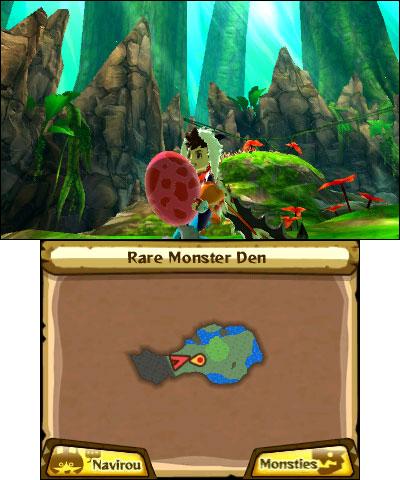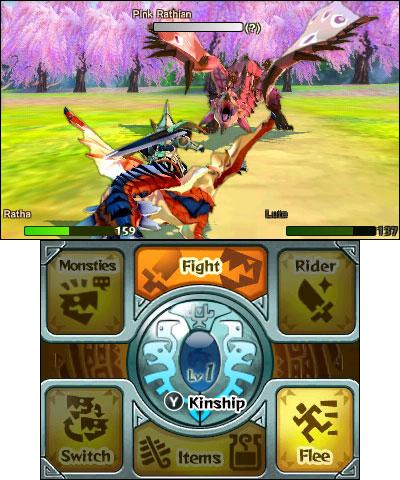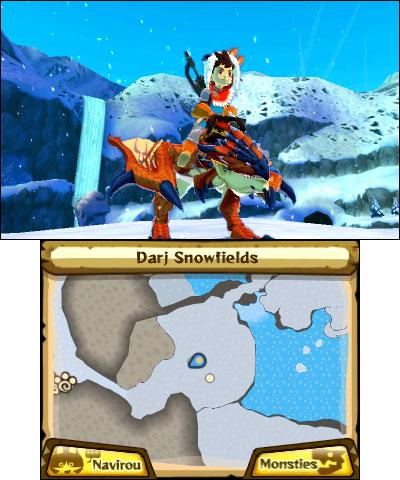
Monster Hunter Stories Review
As long as there are kids playing RPGs, there will be monster collecting games. Whether it's Pokemon, Digimon, Dragon Quest Monsters, or even the more contemporary Yokai Watch - it goes without saying, but kids really love to collect monsters. It seems only inevitable that Capcom would throw their hat into that ring as well, and here we are with Monster Hunter Stories on the 3DS. A story-focused, turn-based RPG Monster Hunter spinoff - which sees players raising their own "Monstie" companions while they traverse the Monster Hunter world, making new friends, and tackling increasingly difficult challenges.
Despite the word "Stories" in the game's title, I don't think the game's story is worth bringing up that much. It's not bad, but MHStories, uh, story, is very by the books, and filled with tropes ranging from the edgy rival with a troubled past, to a mysterious darkness and the prophecy surrounding it, and more. You've got to expect it with a game that is obviously targeting a younger audience compared to the mainline Monster Hunter series, and at least the game has enough of its moments to make it worth seeing to the end.
No, the main draw of Monster Hunter Stories is two-fold - the Monsties themselves, and the slightly unorthodox battle system. Throughout the game world, players can find Monster Dens housing eggs, that when brought back to town can be hatched into a new party member. A variety of different factors, including the type of den that's entered, the weight and smell of the egg, and even the pattern determine exactly what type of monster you'll receive when the egg is hatched, and exactly what attributes that they'll have.

Different Monsters species have distinct abilities and will act accordingly in battle. This goes both ways - your monsters will have as much of a pattern as any of the monsters you'll fight. While players can choose what actions their "Monster Rider" will take, such as whether to use an item, use a skill, or attack using one of 3 attributes - Monsters, for the most part, will act on their own. The core of MHStories turn-based battles is a sort of rock-paper-scissors style meta between Speed, Power, and Technical attacks. Speed will trump Power, Power will beat Technical, and so on... attacks will raise your kinship with your monster, which will allow you to either ride the monster once the gauge is maxed out, or you can spend some of that power to direct your monster to use a specific attack.
Quickly, just learning what type of attack in the triangle a monster is most likely to use won't be enough to take down a foe. Although the core of the combat revolves around countering their basic attacks, monsters can also use other skills - such as buffing themselves, debuffing your party, locking you or your monster from using a specific type of move, calling on help, and more. Interspersed between these more ordinary bits of combat are also minigames that depend on the attributes of both the monster you're facing and the monster that you've brought to face them. If both the monsters can fly, maybe it will be a minigame themed around that. If they can breathe water/fire/what-have-you, you might have to help your monster's breath beat out the opponents.
The game never gets too hard that you'll be stuck on any specific battle for long, but especially when you bring multiple monsters, and targeting specific body parts on certain monsters into the mix - the surprising amount of depth in the combat system really does shine. However, an RPGs combat system alone doesn't make the game, and in MHStories case what really makes it great is the aforementioned egg system, monster channeling, and the monster-riding mechanics.

Sprinkled throughout the world you'll find randomly placed Monster Dens. Inside is a mini-dungeon, and at the end of the dungeon, players can gather eggs to bring back to town to hatch and raise. However, you're never told outright what the egg you've picked up will actually hatch into - or, not directly at least. Different classifications of beasts will have distinctive markings. Bird Wyverns have irregular, rounded splotches dotting the egg, while weaker monsters like an Aptonoth might have an egg with a rounded stripe pattern, that doesn't fully wrap around the egg.
As mentioned prior, the weight and smelliness of the egg also affect the monster's power, but not directly - instead, it determines how many gene slots it has, as well as how many of those slots are already filled in from the get-go. Genes are distributed on what's essentially a tic-tac-toe board, and if any of those lines are complete, the monster's attributes will receive a buff depending on the type of genes in the slots affected. Using Monster Channeling, you can transfer the genes from one monster to another, with the only requirements being that the same slot on the receiving monster must be unlocked and empty. This is illustrated in the game as using a Yian Kut-Ku to give a Lagombi the power to breathe fire, but more or less any gene can be transferred, meaning that players have a surprisingly large amount of freedom to build their teams how they please.

Different monsters are, of course, found in different parts of the map - and you're encouraged to keep finding new monsters with new abilities, as you'll constantly be finding yourself face to face with obstacles that you'll need a specific monster's field ability to get past. Whether it be breaking rocks, swimming, climbing vines, or more. The game might not look quite as good as the other Monster Hunter titles on 3DS, but it's still quite a looker for the system and coupled with a surprisingly great soundtrack I had a blast exploring the world.
At first, I wasn't completely sold on MHStories, but the longer I played the more that the game's heart shone through. The story might not have much depth, but what the game might lack in narrative it more than makes up for with its charm.